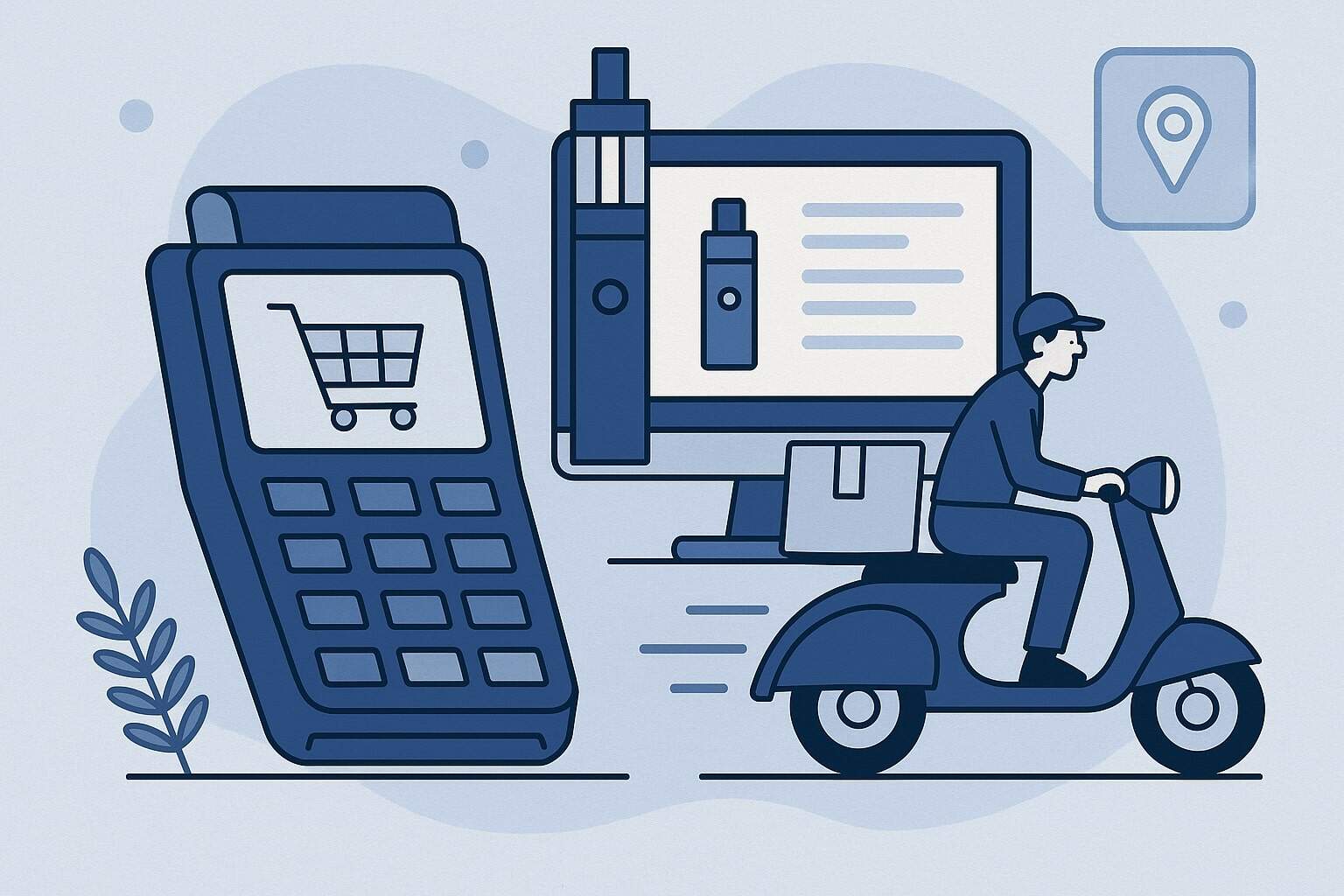
By vapeshoppointofsale September 13, 2025
Modern vape retailers increasingly offer online ordering and home delivery. A specialized point-of-sale (POS) system helps manage inventory, orders and customer data across channels.
In the US, strict rules (e.g. federal Tobacco 21 law) mandate age 21+ for sales. The right POS streamlines age checks and ensures compliance while unifying in-store and online sales.
Why Vape Shops Need Specialized POS
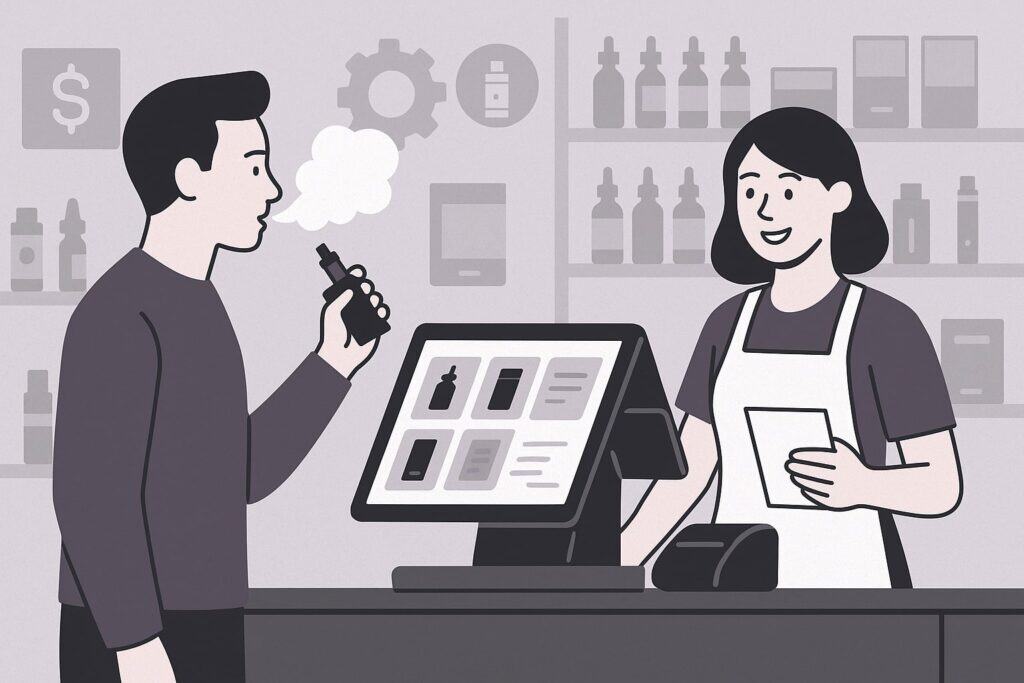
- Regulatory Compliance: Selling e-cigarettes requires verifying customer age (min. 21). New FDA rules (effective Sept 2024) even require checking ID for anyone under 30. Dedicated vape POS can prompt ID scans at checkout and record every age check.
- High-Risk Processing: Banks view vape stores as “high-risk,” often imposing higher fees or restrictions. Top vape POS systems integrate with high-risk payment processors to keep transactions smooth.
- Complex Inventory: Vape shops sell dozens of e-liquid flavors, nicotine strengths, and devices. A vape-savvy POS tracks inventory by flavor, brand and nicotine level, auto-updates stock, and alerts when reordering is needed.
- Rapid Market Changes: Trends shift quickly in vaping. A modern POS provides sales reports and customer data so retailers can adapt stock and promotions fast.
Each of these factors makes a vape-specific POS more than just a cash register: it’s a business management tool. A well-chosen system saves time (by automating tasks like stock counts) and reduces legal risk (with built-in age-gate enforcement).
Key Features of Vape Shop POS Systems
POS solutions for vape shops typically offer:
- Age Verification: Built-in ID scanning or prompts at checkout ensure compliance. Modern POS software validates IDs in seconds and logs every age check.
If a customer is underage, the sale is blocked automatically. Keeping records of all ID scans also helps during audits or inspections. - Inventory Management: Supports hundreds of SKUs (disposables, mods, e-liquids) with detailed tracking. The POS updates stock in real time as sales occur.
Automated reorder alerts prevent running out of popular items. Many systems track batches or expiration dates for regulated products, helping meet safety rules. - Payment Processing: Integration with vape-friendly credit processing. Since many traditional processors avoid vape sales, top POS providers offer or recommend specialized high-risk merchant accounts. This ensures cards, digital wallets and even mobile pay work smoothly at checkout.
- E‑commerce Integration: Built-in or add‑on online store. Several POS systems let vape shops sell on their own website.
Inventory, pricing and customer profiles sync between in-store and online automatically. This unified platform accepts payments online, updates stock, and manages click‑&‑collect or ship orders. - Local Delivery & Pickup: Tools to handle home delivery orders. A modern vape POS can process online orders for in-store pickup or local drop‑off.
For example, ConnectPOS and Quickvee support click‑and‑collect and local delivery with order tracking and customer notifications. Some systems integrate with delivery apps (like DoorDash/UberEats) so third‑party orders route directly into the POS. - Customer Management: Loyalty and marketing features. POS platforms often record every customer’s purchase history. This allows targeted promotions (e.g. discount next pod refill) and automated email marketing. Loyalty programs reward repeat buyers, encouraging customer retention.
- Multi-Store Support: For growing chains, centralized control is vital. A cloud POS shows inventory and sales data for every location in one dashboard. Store managers can transfer stock between branches, set permissions, and see consistent reporting across all outlets.
These features work together to help vape retailers stay organized and grow. For example, with a compliant POS, employees never forget to check IDs (some systems even prompt staff automatically).
Orders placed on the website flow into the same system that rings up in-store sales. This unified approach boosts efficiency and accuracy.
Compliance & Age Verification
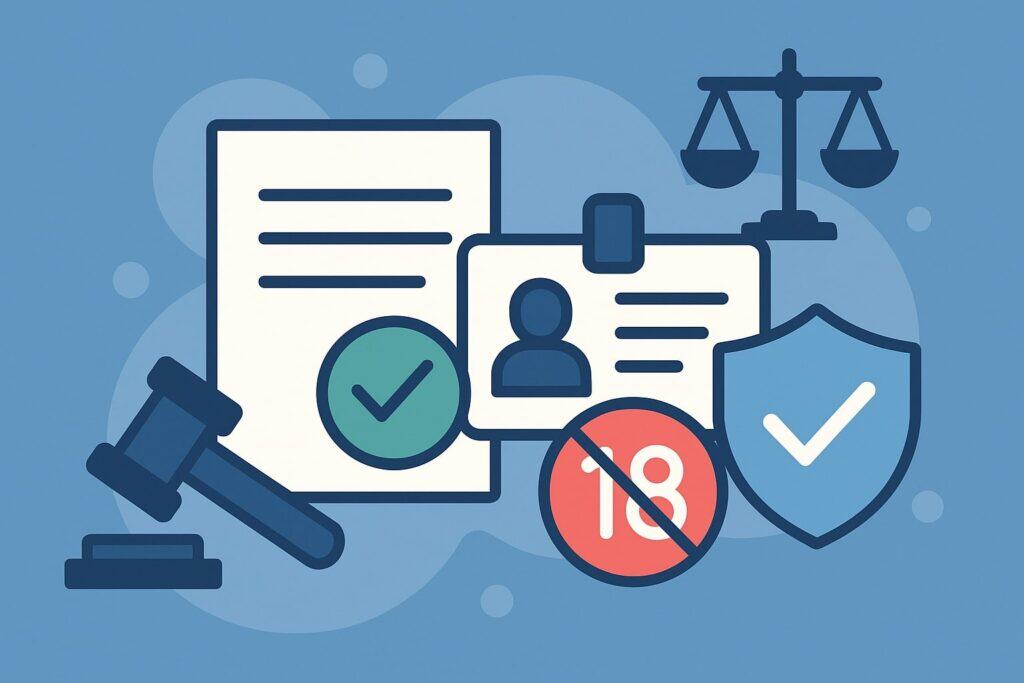
Compliance is critical for vape sellers. Federal law raises the minimum sales age to 21, and as of Sept 2024 the FDA requires ID checks for anyone under 30 at purchase. POS systems enforce this by requiring ID scans at checkout, and they store digital records of each check.
For online orders, compliance must continue. The PACT Act mandates that carriers obtain an adult (21+) signature at delivery and verify ID.
In practice, this means any vape order shipped must have ID verification at drop-off. Modern POS and e-commerce platforms can flag orders for signature and integrate with delivery services that perform age checks on arrival.
Payment Security
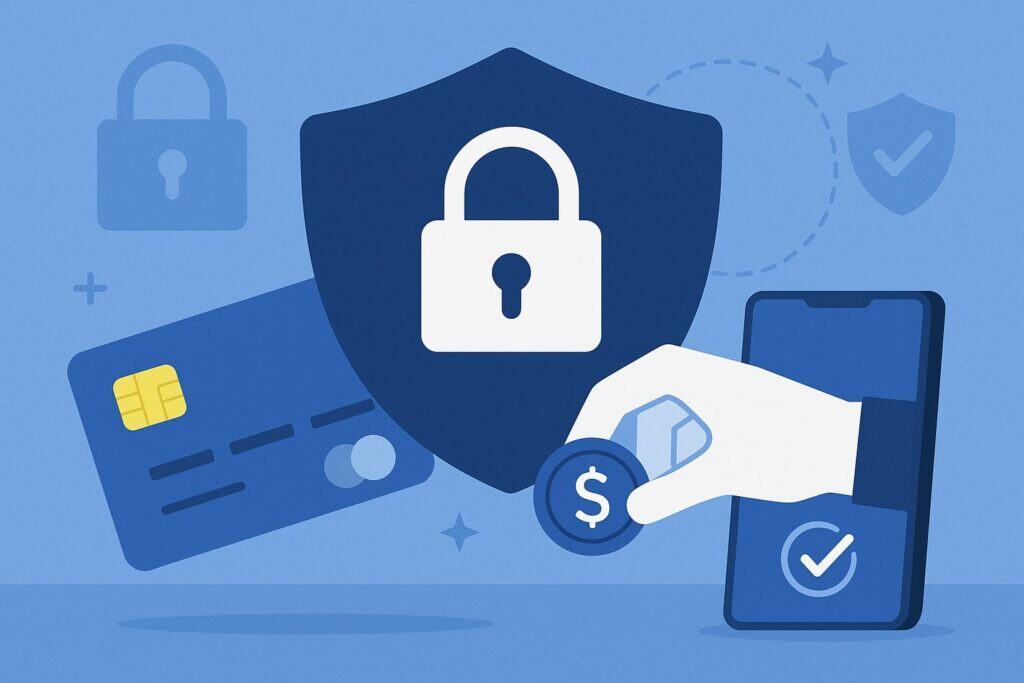
Because vape shops are high-risk, many banks and card networks impose stricter rules. When choosing a POS, it’s important to ensure it supports high-risk payment processing. Some vendors offer in-house payment solutions optimized for vape stores.
This avoids sudden account terminations or exorbitant fees. All payment data should be handled securely (PCI-compliant) and encrypted at the POS.
Online Ordering & Delivery
The COVID era accelerated online ordering for many retailers, including vape shops. Now, customers expect to browse and buy e-liquids and devices online. A modern POS typically includes (or syncs with) an e-commerce platform:
- Website Integration: Systems like Lightspeed and Shopify let you build an online store that mirrors your in-store inventory. When a customer orders a vape kit on the site, the POS automatically records the sale and deducts it from inventory. This real-time sync prevents overselling.
- Omni-channel Checkout: Whether a sale is in-person, curbside pickup or delivery, it appears in one unified system. For example, Quickvee POS can accept orders from your website for both pickup and local delivery. Staff sees the order on their screen just like any other sale.
- Local Delivery Tools: Because shipping vapes nationally is legally tricky (USPS cannot ship vape products to consumers), many stores use local couriers or their own drivers.
POS platforms may include route planning, address limits (delivery zones), and text/email notifications. ConnectPOS, for instance, supports “click-and-collect” and local delivery with built-in order tracking. - Third-Party Delivery: Some shops also partner with delivery apps (DoorDash, Uber, etc.). Through integrations (like Deliverect), POS can import those orders.
For restaurants, Lightspeed offers plugins to receive DoorDash/UberEats orders directly into the POS. Similarly, a vape shop can set up such integrations to avoid phone calls and manual entry.
Technology is also evolving. Some stores experiment with autonomous delivery robots or drones for very local deliveries.
While such solutions are not yet mainstream, they highlight the trend toward quicker, contactless delivery. Even now, basic mobile tools help: customers can prepay online and just show a QR code or order number for pickup.
Overall, a unified POS simplifies “omni-channel” vape selling. Customers see accurate stock online, and orders integrate with in-store workflows. This makes operations smoother and helps comply with all relevant rules.
Comparison of Top Vape Shop POS Systems
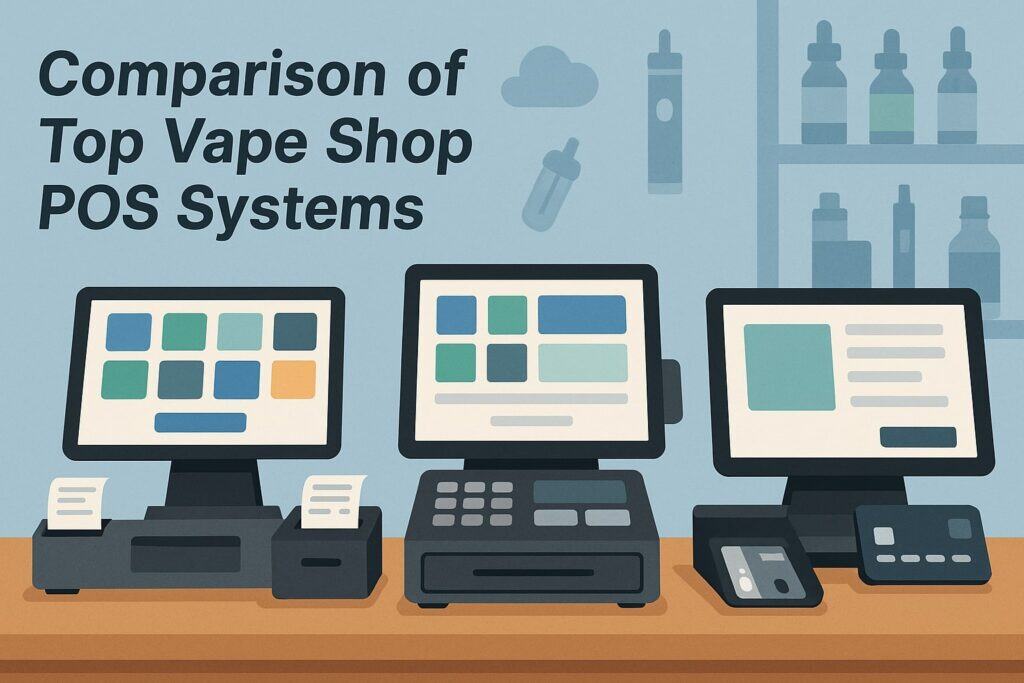
| POS System | Key Features / Strengths | Ideal For | Pricing (approx.) |
|---|---|---|---|
| ConnectPOS | Vape-focused. Built-in age verification, high-risk processing, batch/expiry tracking. Syncs with eCommerce (with age-gating). Supports click‑and‑collect, local delivery and traditional shipping. Centralizes multi-store inventory by flavor/nicotine. | Vape & smoke shops, multi-location chains. | Custom quotes (subscription). |
| Quickvee POS | All-in-one vape/smoke POS & online ordering. Manages in-store and web orders together. Automated loyalty rewards, mix‑n‑match promos, and payment processing built in. Cost-effective for small shops. | Independent smoke/vape shops expanding online. | Pay-as-you-go (subscription). |
| Lightspeed Retail | Cloud POS with advanced inventory and customer tools. Includes built-in eCommerce website builder with SEO, plus reports and marketing. Supports omnichannel sales and integrates with payments. Scalable for multi-store. | Medium-to-large retailers and franchises. | From ~$89/month (Retail plan). |
| FTx POS | Vape industry specialist. Emphasizes age/ID scanning (in-store and online), tax/compliance settings, and best-rate high-risk payments. Full inventory control with automated reordering. Known for serving large smoke shop chains. | Smoke/vape shops of all sizes needing industry support. | From ~$89/month (starter plan). |
| KORONA POS | Retail POS with built-in ID scanning at checkout. Robust inventory (mass edits, auto-reorder) and customizable pricing. Multi-store capabilities and staff permissions. Offers loyalty points and gift cards. | Growing retail shops (including multi-outlets). | Tiered plans (quotes on request). |
| Shopify POS | Seamless integration with Shopify e-commerce. Unified inventory/CRM online and offline. Provides basic age-gate plugins. Fast setup for shops already on Shopify. (Note: Shopify’s payment fees higher on non-Shopify payments.) | Small shops focused on online sales or beginners. | From $89/month (Basic plan). |
| Square for Retail | Free entry-level plan. Easy to use, with offline sales mode and basic inventory alerts. Includes basic age verification prompts (with add-on or manual). USB hardware compatibility. Not specialized for high-risk (extra fees may apply). | Small, budget-conscious retailers or startups. | Free/$89+ per month (Retail plan). |
Each system has pros and cons. For example, ConnectPOS is purpose-built for vape/smoke shops and excels in compliance features. Lightspeed is powerful and integrates a full e-commerce site, but can be pricier.
Quickvee is a low-cost all-in-one option for local shops wanting online pickup/delivery. Shopify and Square offer easy setups but may need extra apps for strict vape compliance.
Retailers should consider store size and growth plans. A single-location shop might prioritize low cost and ease of use (Square, Quickvee, Shopify). A multi-store chain needs central management and advanced reporting (Lightspeed, ConnectPOS, KORONA). Always test with free trials: most vendors let you demo the software before buying .
FAQs
Q: What features should a vape shop POS include?
A: Key features are comprehensive age verification (ID scanning), detailed inventory control for thousands of SKUs, and compliance tracking (batch/expiry records).
Other essentials: integration with online sales (so stock syncs across channels) and support for local delivery or pickup orders. Loyalty programs and multi-store management are also common features.
Q: How does a POS system handle age verification?
A: Most specialized POS systems prompt the cashier to scan the customer’s government ID on vape purchases. The software reads the birthdate and immediately blocks the sale if the customer is under 21.
The POS also logs each check for record-keeping. For online orders, the POS or e-commerce platform will require age confirmation and may flag orders for ID verification at delivery.
Q: Can these POS systems manage both in-store and online vape sales?
A: Yes. Many vape-capable POS platforms offer unified omni-channel functionality. They either include a built-in website or connect to major e-commerce tools. For example, Lightspeed and Shopify let you run a vape store site that syncs inventory.
Orders from the web, in-store pickup or delivery all appear in the same POS. Systems like Quickvee explicitly support seamless in-store and online ordering, so inventory and customer data stay up-to-date everywhere.
Q: Are these POS systems compliant with vape sales regulations?
A: Yes. The top vape POS vendors regularly update software to meet federal and state regulations. They enforce Tobacco 21 age checks and can track regulated substances.
For example, ConnectPOS and others are built to handle legal requirements without slowing checkout. However, retailers must also follow other rules (like requiring adult signature on delivery). A good POS makes compliance easier, but shop owners should stay informed on the latest laws.
Q: How do vape shop POS systems integrate delivery orders?
A: These POS solutions often include delivery management features. They allow you to enter local delivery orders just like any sale, assign them to drivers, and send notifications.
Some systems integrate with delivery apps (DoorDash, etc.) through middleware (Lightspeed+Deliverect is one example). They can set delivery zones so the system only accepts orders deliverable in range. Overall, the POS treats delivery and pickup orders as part of its order tracking process.
Q: What about payment processing for vape shops?
A: Vape shops are considered high-risk, so not all payment services work. Many vape-friendly POS systems bundle or recommend specialized processors that accept e-cigarette sales.
These integrated payment options simplify setup. Regardless of choice, ensure the POS and payment service are PCI-compliant and secure, so all customer card data is protected.
Conclusion
A modern POS is the backbone of a successful vape retail business. It ensures every online or in-store sale is logged, age-checked and compliant. It keeps hundreds of SKUs organized, helps prevent stockouts, and unifies customer data for marketing.
With vape products subject to evolving laws and shipping bans, having a single system that ties together inventory, online orders, and deliveries is essential.
In summary, vape retailers should choose POS solutions that prioritize age verification and compliance, integrate e-commerce and delivery, and support their payment needs. The right POS will boost efficiency and customer trust, letting owners focus on business growth rather than paperwork.
Always evaluate features (ID scanning, eCom, delivery support) against your store’s specific needs, and leverage free trials or demos. The result: smoother checkouts, happier customers, and a compliant, future-ready vape business.